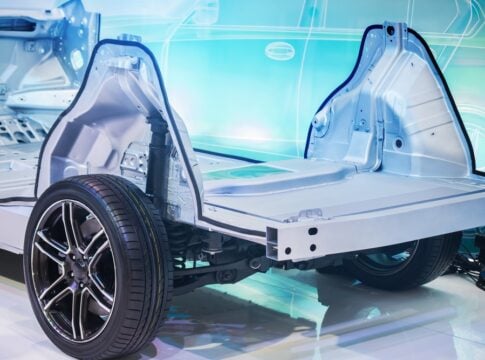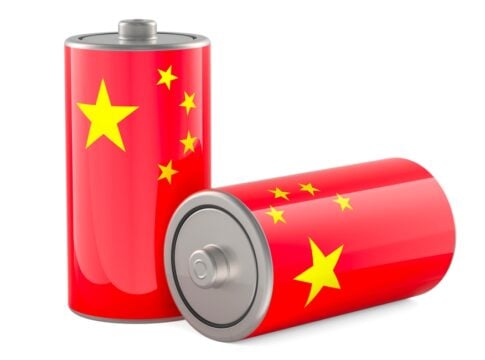Most industrial greenhouse gas (GHG) emissions come from energy use. By improving energy efficiency, the world can cut energy consumption, lower emissions, and save on costs. It’s a smart and cost-effective first step toward decarbonization and businesses are continuing to pour funds into energy efficiency initiatives and technologies worldwide as the International Energy Agency (IEA) reported.
The IEA’s Energy Efficiency 2024 highlights key trends in energy intensity, demand, prices, and policies. It also offers insights into system-wide themes including investment, which this article will delve into in detail.
Driving Change: What Leads the Energy Revolution?
The report shows that energy efficiency investments could remain resilient in 2024, with total spending projected to reach around $660 billion. This level matches the record set in 2022 and highlights the steady commitment to sustainable energy use. These investments span sectors like transport, buildings, and industry, driven by the need to reduce emissions and enhance energy efficiency amid fluctuating economic conditions.
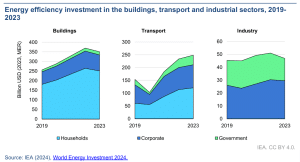
Since 2019, global energy efficiency investments have surged by 45%, fueled by the energy crisis and significant government spending post-Covid-19. The transport sector has seen the highest growth, with a 77% rise, followed by buildings at 34% and industry at 13%.

However, from 2022 to 2024, the trend shifted. Investments in buildings dropped by 7%, while transport saw a 14% rise, and industry remained steady.
A key driver for the trend is the push for efficient electrification, especially in the electric vehicle (EV) sector across China, Europe, and North America. EV sales, particularly in emerging markets, have supported this trend.
However, as energy prices stabilize and government stimulus wanes, overall global investment has plateaued. Rising inflation and interest rates also pose challenges for financing efficiency upgrades.
Emerging Markets Take the Spotlight in Efficiency Investments
The growth of efficiency-related investments in 2024 is uneven across regions. Emerging markets and developing economies (EMDEs) are expected to lead.
Africa is projected to see a 60% rise, the Middle East 40%, and Central and South America over 20%. China will also witness nearly 10% growth.
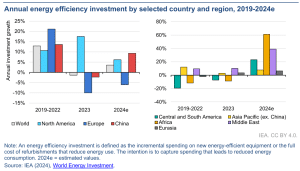
Conversely, advanced economies are stabilizing after years of crisis-driven spending. Europe is set for a slight decline, while North America will see a modest 5% increase.
Despite slower growth in these regions, they still account for the bulk of global energy efficiency investments—95% of total spending occurs in Europe, Asia Pacific, and North America, regions responsible for about 75% of global energy demand.
Transport Electrification: A Surge in EV Sales
Globally, the electrification of transport has gained momentum. By 2024, around one in five new cars sold will be electric.
EV sales reached 14 million in 2023, making up 18% of total car sales, and this figure is expected to grow to 17 million in 2024. The bulk of these sales occurred in China, Europe, and North America, which accounted for 95% of global EV sales.
In EMDEs, the focus remains on two- and three-wheelers. These vehicles dominate markets in regions like Southeast Asia and Latin America. China leads in two-wheeler sales, though global sales in this category dropped 18% in 2023 due to supply chain disruptions.
India, however, saw a 40% increase in electric two-wheeler sales and continued growth in three-wheelers, spurred by government initiatives like the Electric Mobility Promotion Scheme.
- RELATED: Is the EV Market’s Momentum Slowing?
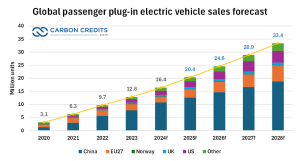
According to S&P Global data represented by the chart below, global passenger plug-in EV sales could reach over 33 million units by 2028. That’s almost a 104% increase in EV units sold. China is set to take the biggest growth in sales.
The number of people projected to use EVs for the same period (penetration rate) will also double by 2028 compared to 2024.

Source: S&P Global
Building Smarter: A Post-Crisis Slowdown
Investment in energy-efficient buildings boomed during the energy crisis, driven by technologies like heat pumps. In 2022, heat pump sales peaked, particularly in Europe, where they are central to long-term climate goals.
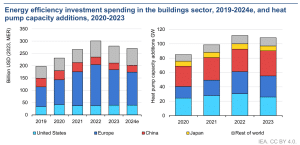
However, this momentum slowed in 2023 due to high electricity prices and reduced government support. For instance, Italy’s Superbonus program, which heavily subsidized energy-saving renovations, was phased out in 2024. This program alone accounted for more than half of Italy’s building sector investments in 2023.
Meanwhile, heat pump deployment in China has seen modest growth. These trends highlight the critical role of government policies in sustaining investment in building efficiency.
ESCOs and the Power Players Behind the Efficiency Boom
The energy service company (ESCO) market experienced a slight decline in 2023, dropping by 2.2%. Despite this, the market size remains robust at over $35 billion, supported by strong policies in regions like the U.S.
Federal programs, such as the Federal Energy Management Program, have bolstered ESCO activities, which grew by 54% between 2021 and 2023 in the U.S.
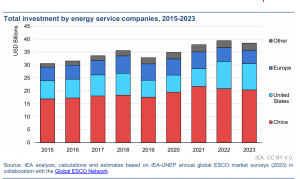
China leads the global ESCO market, with investments exceeding $20 billion in 2023, accounting for half the global total. The majority of ESCO investments target the buildings sector, followed by industrial applications and energy storage.
Among the major players in the ESCO market, some of the interesting companies making waves in the sector include:
- Johnson Controls is a global leader in smart building solutions, offering advanced technologies and services to enhance building performance and sustainability. In energy efficiency, Johnson Controls has made significant progress by implementing high-capacity heat pumps and optimizing energy use in various industries. They have contributed to over $6 billion in customer projects worldwide, driving sustainability and reducing carbon footprints.
- Ameresco is a leading cleantech integrator that specializes in energy efficiency, renewable energy, and infrastructure modernization. In 2023, its renewable energy projects and assets helped avoid around 16 million metric tons of CO₂ emissions, contributing to over 110 million metric tons of cumulative carbon reductions since 2010. Ameresco has received numerous awards for its sustainability efforts and continues to drive innovation in clean energy.
- Trane Technologies, through its flagship brand Trane, provides innovative HVAC solutions designed for energy efficiency and sustainability. The company delivers services such as Energy Savings Performance Contracting (ESPC) to optimize energy consumption and reduce operational costs for buildings. Trane emphasizes sustainability, helping clients meet carbon reduction goals through electrification, energy monitoring, and renewable energy integration.
- NORESCO is specializing in energy and infrastructure solutions for government, institutional, and commercial clients. The company has a strong track record in improving energy efficiency, managing over $2.75 billion in federal energy projects. It helps clients achieve sustainability goals through advanced technologies like microgrids, battery storage, and renewable energy systems.
Scaling Up: What’s Needed for 2030?
To meet net-zero targets, energy efficiency investments must triple by 2030, reaching $1.9 trillion annually, per the report. The IEA’s NZE Scenario underscores the importance of a comprehensive strategy tailored to each country’s needs.
In emerging economies, efforts focus on improving building performance and electrifying transport. In sub-Saharan Africa, the transition to clean cooking fuels is a top priority. Advanced economies, meanwhile, focus on retrofitting older infrastructure, deploying heat pumps, and scaling up EV infrastructure.
Ultimately, energy efficiency investment is vital for meeting global climate goals and expanding investment to underrepresented regions will be key to accelerating progress.
The post Energy Efficiency Hits $660 Billion in 2024: The World’s Best Bet for Cutting GHG Emissions appeared first on Carbon Credits.
Carbon Footprint
How NVIDIA, Microsoft, Musk’s xAI, and BlackRock Are Driving the Next Wave of AI: $60 Billion in Mega Deals Explained
NVIDIA continues to cement its position as a leading force in the artificial intelligence (AI) industry. Its powerful chips are now the foundation of massive data centers and AI systems across the world. Recent deals worth more than $60 billion highlight how deeply the company is shaping the future of global computing.
Industries like healthcare and finance are turning to AI. NVIDIA’s hardware and software are now key to digital transformation. The company is both selling chips as well as designing the global infrastructure for smart technologies.
Growing Global Demand for AI Computing
Modern AI models demand enormous computing power. Training chatbots, autonomous driving systems, or image-recognition tools involves processing millions of calculations per second. NVIDIA’s graphics processing units (GPUs) are built for this type of workload.
Unlike traditional chips, GPUs can handle many tasks at once, making them ideal for AI training and inference. NVIDIA’s efficiency has made it the go-to supplier for big cloud providers, research institutions, and AI startups.
In 2025, global demand for AI computing surged. Governments and private companies are building large-scale data centers around NVIDIA’s technology. These facilities help create advanced AI models. They can be used for tasks like weather forecasting and logistics optimization.

Billions in Global Infrastructure Partnerships
NVIDIA has signed major partnerships worth about $60 billion in total. These include agreements across cloud services, chip deployment, and full-scale data center construction.
A key highlight is the $14 billion contract between Microsoft and Nscale, a British AI cloud company. This deal will deploy about 200,000 NVIDIA GB300 GPUs. The installations will span the United States and Europe, with 104,000 GPUs located at a 240-megawatt facility in Texas set to open in 2026. Additional sites include 12,600 GPUs in Portugal and 23,000 in England by 2027.
Another big deal includes BlackRock, Microsoft, NVIDIA, and Elon Musk’s xAI. They just announced a $40 billion purchase of Aligned Data Centers. The company operates over 50 campuses with more than 5 gigawatts of total capacity across North and South America. This is the biggest data center purchase ever. It also boosts NVIDIA’s role in the AI Infrastructure Partnership (AIP) initiative.
NVIDIA is more than a chip supplier now. These big collaborations show it’s a key partner in creating and powering the next generation of AI infrastructure.
Musk Bets Big on NVIDIA in a $20B Chip Pact
One of the most ambitious projects tied to NVIDIA is xAI’s $20 billion lease-to-own deal for AI chips. Led by Elon Musk, xAI plans to use the financing to build the Colossus 2 data center in Memphis, Tennessee.
The project will deploy 300,000 to 550,000 NVIDIA GB200 and GB300 chips, scaling up from xAI’s current 200,000-processor facility. The arrangement involves about $7.5 billion in equity and $12.5 billion in debt, using a special purpose vehicle (SPV) structure.
In a unique twist, NVIDIA is investing up to $2 billion in the SPV’s equity, effectively financing part of its own hardware. The debt is secured by the GPUs, not xAI’s corporate assets. This gives lenders direct security linked to the equipment.
This five-year lease model helps xAI access cutting-edge computing power without taking on the full debt burden. It also ensures NVIDIA a steady income stream and longer-term control over chip distribution.
NVIDIA Stock Moving Up, Market Going Up
NVIDIA’s stock went up a bit today. The market responded to corporate announcements and infrastructure deals. The gain shows that investors believe these big deals will increase future revenue and strengthen NVIDIA’s position in the AI ecosystem.
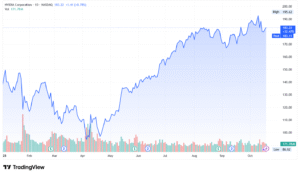
Although the increase isn’t dramatic, it shows that traders view this news as adding value. Stable stock gains can draw more interest from institutional investors. They look for long-term growth potential.
As news about these deals spreads, more people in the market may view NVIDIA as more than just a chipmaker. They might see it as a key player in AI infrastructure. That perception can help support longer-term stock strength.
The AI infrastructure market is growing fast and looks set to keep expanding for years. Analysts estimate the AI-infrastructure market hit $87.6 billion in 2025. It could almost double by 2030. This growth comes as companies invest in GPUs, networking, and cooling systems.
Data center power needs are rising fast. Forecasts suggest that by 2027, demand could hit about 92 GW. This growth is mainly due to AI workloads.
Firms and governments might need trillions in new capital to meet demand. One major study estimates that data-center investments could reach about $8 trillion by 2030 in a high-growth scenario.
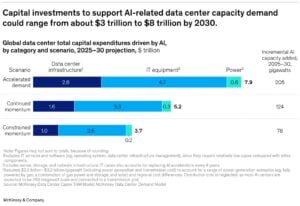
Market research groups predict that AI data centers will grow at a compound annual growth rate of 25–32% through 2030. This means strong ongoing investment in chips, facilities, and power.
ESG, Sustainability, and Environmental Impact
Large AI data centers, like those powered by NVIDIA’s chips, have significant environmental footprints. The energy they consume and the cooling systems they require can contribute to greenhouse gas emissions and heavy water use.
In the xAI Colossus 2 project, the energy demand alone is over 1 gigawatt, comparable to the power needs of nearly a million households. Cooling will use millions of gallons of water daily. The facility uses methane turbines. This has led to complaints from environmental groups about air pollution and regulatory issues.
Because of this, NVIDIA and its partners will need to address sustainability. They may invest in cleaner power sources like solar or wind. They might also implement advanced cooling technology that uses less water or captures waste heat. Efficient chip designs that consume less power will be critical, too.
These sustainability efforts can influence public perception, regulatory approvals, and long-term cost structure. If NVIDIA proves it’s cutting emissions and lowering environmental impact, it boosts its role as a tech leader and a responsible partner for a greener future.
The Heat Is On: Rivals, Regulation, and Rising Power Costs
Despite its momentum, NVIDIA faces real challenges. Global demand for GPUs still exceeds supply, leading to long waiting times for deliveries. The company depends on semiconductor foundries like TSMC. So, any delays in production can affect big projects.
Competition is growing as well. AMD, Intel, and new AI-focused startups are developing their own advanced processors. These firms aim to capture part of the rapidly expanding AI chip market.
NVIDIA also faces regulatory and environmental risks. Export limits might cut sales in important areas. Also, AI data centers use more energy, which brings up sustainability issues. Meeting demand responsibly will require cleaner energy sources and more efficient chip designs.
What’s Next: NVIDIA’s AI Empire Expands
Looking ahead, NVIDIA is expected to continue expanding its global partnerships and data center influence. The company could move deeper into AI infrastructure services, offering combined packages of chips, software, and cloud capacity.
Future growth may also come from:
- AI-as-a-Service platforms for governments and enterprises.
- Cloud partnerships that give smaller developers access to advanced GPUs.
- Next-generation chip designs with better performance per watt.
- Sustainability initiatives to reduce energy use and emissions in data centers.
NVIDIA’s new partnerships include $60 billion in infrastructure deals and $20 billion in chip leasing. These moves show its growing role in AI innovation. The company’s chips now support projects that define the next era of computing, from massive data centers to advanced autonomous systems.
While competition and environmental pressures will continue to test its leadership, NVIDIA’s global reach and ability to adapt ensure it will stay a key player in the race to build the world’s AI infrastructure.
The post How NVIDIA, Microsoft, Musk’s xAI, and BlackRock Are Driving the Next Wave of AI: $60 Billion in Mega Deals Explained appeared first on Carbon Credits.
Carbon Footprint
Aluminum Prices Hit 3-Year High: Is It the Next Key Metal in the Clean Energy Shift?
Aluminum is moving from a supporting role to center stage in the global green transition. The metal is light and strong, and also endlessly recyclable. This makes it essential for electric vehicles (EVs), solar panels, power lines, and low-carbon buildings.
Global demand for aluminum is rising fast as countries expand renewable power and electric transport. The International Aluminium Institute (IAI) expects aluminum demand to rise by 40% by 2030. This growth is fueled by clean-tech uses.
But as the market expands, so does scrutiny on emissions. Aluminum smelting is one of the most energy-intensive industrial processes in the world. Reducing its carbon footprint is now a top goal for both industry and governments.
Aluminum Prices Hit 3-Year High Amid Tight Supply
On October 10, 2025, aluminum prices surged to their highest level in three years, topping around $2,800 per tonne. The rally shows rising supply worries and increasing demand from clean energy sectors. This includes electric vehicles (EVs), renewable power, and construction.

Analysts attribute the spike to several factors. China’s power shortages have limited smelting output. Also, new environmental rules are tightening production limits on coal-powered plants. In addition, unrest in Guinea, which supplies over 45% of China’s bauxite imports, has raised fears of disruptions in the global supply chain.
Meanwhile, inventories tracked by the London Metal Exchange fell to their lowest point since 2021, signaling a tightening market.
“Supply can’t keep up with the clean-energy boom,” said analysts from BloombergNEF. They pointed out that aluminum’s use in solar, EVs, and transmission lines is growing faster than producers can adapt.
The recent price rise shows that investors prefer low-carbon aluminum. This type of aluminum now has a significant premium. Demand for verified low-emission materials is outpacing supply. This is the case for automakers, construction firms, and renewable developers in Europe and North America.
Experts think that prices over $2,500 per tonne could boost investments in recycling and renewable-powered smelters. This is especially true in places like Canada, Norway, and the Middle East. However, the rally also underscores a broader challenge: balancing the green transition with resource security.
Why Aluminum Is the Unsung Hero of Clean Energy
Aluminum saves weight — and that means energy. Lighter cars and trucks travel farther on the same battery charge. According to the Aluminum Association, modern EVs use 30–40% more aluminum than traditional gas vehicles.
It’s not just cars. Each 1-MW solar farm uses roughly 40 tons of aluminum for panel frames, mounts, and wiring. Power grids also rely on aluminum for transformers and long-distance transmission lines.
The metal’s high recyclability adds major sustainability value. Recycled aluminum uses only 5% of the energy required for primary production. Yet recycling accounts for only about 36% of global aluminum output today, leaving huge room for expansion.
The low-carbon aluminum market was 19.3 million tons in 2024, per IMARC estimates. It can grow to 27.7 million tons by 2033, with an annual growth rate of 3.7%. That growth mirrors global renewable investment trends.

China’s Dominance and the Global Supply Imbalance
China dominates the aluminum industry. It produces over 40 million tons of primary aluminum annually — nearly 60% of global supply. It also tops in refining and processing, as well as in demand for raw materials like bauxite.

Exports of bauxite from Guinea to China jumped 35% in 2024, making Guinea the world’s top bauxite exporter. This raw material feeds China’s vast smelting network.
Worldwide, primary aluminum production has topped 70 million tons in recent years. But the carbon footprint varies greatly by location.
Smelters powered by coal — common in parts of China — emit far more CO₂ than those powered by renewables. Producers in Norway, Iceland, and Canada use hydropower. They create aluminum with emissions below 4 kg CO₂ per kg aluminum. This is much lower than the global average of 16.7 kg CO₂ per kg (IAI, Hydro).
This huge gap shows why energy source matters as much as output in the global supply chain.
The Emissions Problem — and Low-Carbon Solutions
Traditional aluminum production is energy-hungry. The International Energy Agency (IEA) estimates that aluminum accounts for around 2% of global CO₂ emissions from materials production.
Producers are now turning to renewable power and recycled inputs to cut this footprint. Norsk Hydro, for example, produces low-carbon aluminum emitting only 3 kg CO₂/kg, among the world’s cleanest.
If all smelters switched to renewable power, global aluminum emissions could fall by 400 million tonnes of CO₂ each year. That’s like the yearly emissions from 100 coal plants.

Recycling is another big win. Recycling rates in Europe could double by 2030, potentially saving 39 million tonnes of CO₂ per year by 2050. Globally, if all used aluminum were recycled, the industry’s total energy demand could fall by 60%, says MARC Group.
Pricing, Premiums, and the Push for Low-Carbon Metal
Aluminum remains a major commodity. The global aluminum market was valued at roughly $190 billion in 2024, with steady growth projected through 2030.
The IAI forecasted the following for aluminum demand growth by 2030:
-
By Region:
Around 93% of global aluminum demand growth between 2020 and 2030 will come from Asia (especially China), Europe, and North America, reflecting industrial expansion, renewable power deployment, and strong EV manufacturing in these regions.
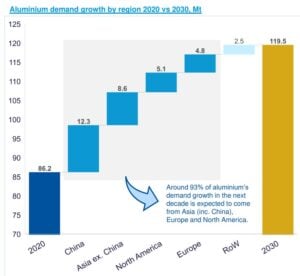
-
By Sector:
Aluminum demand is set to grow most in transportation (+11.8 Mt), followed by electrical (+5.2 Mt), construction (+4.6 Mt), and packaging (+3.3 Mt) — with transport leading due to electric mobility and the electrical sector driven largely by solar and renewable infrastructure. -
By EV Demand:
Electric vehicles will account for roughly 63% of new aluminum demand in transport, adding about 7.4 million tonnes by 2030; EVs use 60–80 kg more aluminum per vehicle than traditional models, with China, Europe, and North America driving about 93% of this growth.
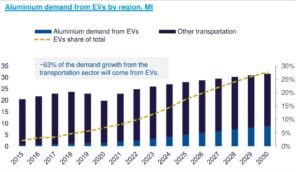
Low-carbon aluminum commands a premium. Market data shows that buyers pay $20 to $150 per tonne more for certified low-carbon products, depending on the region and energy source.
Smelters that use renewable power gain a cost edge as carbon pricing expands. For instance, hydropower-based smelters in Iceland and Quebec report operating costs up to 30% lower than coal-based plants in China.
Investment in renewable-powered smelting hubs is also accelerating. In 2025, new projects in Europe, Canada, and the Middle East are expected to increase global capacity for low-carbon aluminum by 3–4 million tons.
Industry Moves, Policy Levers, and Challenges Ahead
Automakers, electronics makers, and construction firms are driving the shift. Mercedes-Benz, Apple, and Volvo all signed long-term contracts for low-carbon aluminum to cut supply chain emissions.
The European Union’s Carbon Border Adjustment Mechanism (CBAM), set to take effect in 2026, will tax imports based on embedded CO₂. This policy will pressure high-emission producers to decarbonize faster.
Governments are also funding clean smelting projects. In 2025, the U.S. Department of Energy awarded over $500 million program. This program aims to boost aluminum decarbonization and improve recycling infrastructure.
Countries rich in bauxite, like Guinea and Indonesia, are enjoying higher global demand. However, they also face pressure to improve environmental standards in mining and refining.
Scaling low-carbon aluminum faces three main challenges:
- Energy transition: Replacing fossil electricity with renewables near smelters requires billions in new investments.
- Recycling infrastructure: Global collection systems remain fragmented; less than 40% of post-consumer scrap is recovered.
- Verification: Without strict standards, false “green aluminum” claims risk damaging trust.
Aluminum could become one of the biggest enablers of decarbonization. Every tonne of low-carbon aluminum can reduce lifecycle emissions in cars, solar farms, and power lines by several tonnes of CO₂.
To meet climate goals, producers, investors, and governments must collaborate. Expanding renewable energy for smelting is key. Scaling up recycling is also important, as well as having traceable and verified supply chains to succeed.
With the right policies and innovation, aluminum can become a cleaner material. It can support the energy transition by helping create lighter, stronger, and more sustainable systems.
The post Aluminum Prices Hit 3-Year High: Is It the Next Key Metal in the Clean Energy Shift? appeared first on Carbon Credits.
Carbon Footprint
China’s Grip on Lithium Tightens as Global Supply Struggles to Keep Up
China has strengthened its hold on the world’s lithium supply chain. The Ministry of Commerce (MOFCOM) updated China’s catalogue of technologies prohibited or restricted from export. They added important battery and lithium processing technologies. This includes lithium carbonate and hydroxide preparation, along with cathode material manufacturing.
The metal is essential for electric vehicles (EVs) and battery storage. With control over lithium mining, processing, and manufacturing, China now dominates nearly every part of this fast-growing sector.
The move lets Beijing control what technical know-how leaves China. It also strengthens its grip on the clean energy supply chain. This control affects global lithium prices, investment, and clean energy goals across Europe, the U.S., and Asia.
China’s Expanding Role in Lithium Production
Lithium demand has soared as countries push for cleaner transport and renewable energy. The International Energy Agency (IEA) says global lithium demand jumped almost 30% in 2024. This rise came mainly from EV production and big battery storage needs.

China produces about 18% of the world’s mined lithium, but its real strength lies in refining. Chinese companies hold about 65% of the world’s lithium chemical processing. They also account for over 75% of global battery cell production. These numbers show that even if lithium ore is mined in Chile, Argentina, or Australia, most of it ends up in Chinese refineries, which process it into battery-grade material.
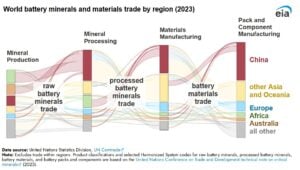
China also leads in midstream and downstream battery manufacturing. In 2024, China made more than 1,200 gigawatt-hours (GWh) of lithium-ion batteries. That’s around three-quarters of the world’s total, as reported by BloombergNEF.
Major producers like CATL and BYD supplied both domestic and foreign automakers, including Tesla, BMW, and Toyota.
The country’s major players, such as Ganfeng Lithium and Tianqi Lithium, have spent years investing in foreign mines. They invest in lithium projects in South America, Africa, and Australia. This helps them secure long-term access to raw materials. This strategy ensures China’s industry gets the feedstock it needs, supports local gigafactories, and boosts global exports.
How Beijing’s Moves Sway Global Lithium Markets
Lithium prices have been on a roller coaster. After record highs in 2022, prices dropped sharply in 2023 and early 2024 due to oversupply. But by mid-2025, prices in China began to rebound. Lithium carbonate traded between CNY 59,000 and 69,000 per metric ton (roughly US$8,500–9,000).
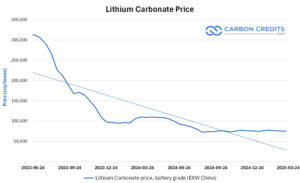
Industry analysts say Chinese producers used this price flexibility to outcompete foreign suppliers. When prices drop, many non-Chinese mining firms, especially in Australia and Africa, struggle to stay profitable.
Some market experts think China oversupplied the market on purpose. They believe this was to keep global influence and slow down rival producers.
Despite recent rebounds, volatility remains high. The IEA warns that lithium demand may double by 2030. It could reach over 1.3 million tonnes of lithium carbonate equivalent (LCE) each year. Without new mines and processing capacity, global shortages might return. This could lead to price spikes that impact battery and EV production worldwide.
- SEE LITHIUM PRICES here…
Technology and Export Controls
China’s advantage goes beyond production scale. It now leads in processing technology, equipment, and battery chemistry. Beijing is now limiting exports of lithium-processing machines and technology. This move aims to protect local industries and manage intellectual property.
In 2025, several Chinese equipment suppliers limited shipments abroad. This makes it harder for competitors in the U.S. and Europe to build their own refining systems. These export limits are part of a broader strategy to keep the high-value stages of the supply chain inside China.

Meanwhile, the U.S. IRA provides up to $369 billion for climate and energy. It includes strong incentives for local battery and mineral production. Europe’s Critical Raw Materials Act aims for 40% of critical minerals used in the EU to come from local or allied sources by 2030. But industry analysts say it could take up to a decade for these efforts to significantly reduce dependence on China.
The Global Response: Diversifying Supply Chains
Governments and companies are now racing to reduce dependence on China. The United States, Canada, and Australia are expanding domestic mining and refining. Chile and Argentina, along with other South American nations, are building local industries. They aim to process lithium instead of just exporting raw materials.
- RELATED: U.S. Lithium Push: How Washington’s Bet on Lithium Americas Could Reshape the Global Market
The IEA warns that global lithium supply must increase sevenfold by 2035 to meet climate goals. That means bringing new mines and refineries online faster while maintaining environmental standards.
In 2024, the World Bank estimated that over €680 billion (US$730 billion) was invested in renewable power and storage. However, only a small part funded the raw material supply. If supply growth lags, battery shortages could slow EV production by the late 2020s.
However, challenges persist. Lithium extraction can strain water resources and ecosystems. Building new facilities also requires stable regulation and financing, which can take years to secure.
Surge Battery Metals: Strengthening North American Supply
In North America, one of the emerging players helping to diversify lithium supply is Surge Battery Metals (CSE: NILI). The company is developing the Nevada North Lithium Project. This project is in one of the U.S.’s most promising lithium-rich areas.
Surge aims to produce battery-grade lithium for the growing North American EV market. Its exploration results have shown strong potential for large-scale, high-grade lithium clay deposits. Projects like Surge’s align with U.S. efforts to build a secure domestic supply chain and reduce reliance on imports from China.
Surge helps ensure supply security and meet environmental goals by creating cleaner extraction and processing methods. Its work supports the U.S. Department of Energy’s plan to create a domestic battery materials supply chain. It seeks to meet 90% of the country’s lithium demand by 2035.
What’s Ahead: Competition, Cooperation, and Climate Goals
The global lithium race is about more than profits. It shapes the pace of the clean energy transition. China’s dominance gives it both economic power and geopolitical influence. Western economies are investing a lot to find new supplies and to lower strategic risks.
The market outlook suggests demand will remain strong throughout the decade. Analysts expect lithium prices to stabilize as new supply enters the market, but competition will remain intense.
For the world to meet its climate goals, cooperation will be as important as competition. Shared technology, recycling, and sustainability standards could help reduce emissions and stabilize supply chains.
Surge Battery Metals and other new miners are working to localize production. They aim to boost transparency and ensure lithium supply helps the clean energy transition, not hinders it.
China now controls the heart of the global lithium industry, from mining and refining to battery exports. This dominance brings both opportunity and risk. The rest of the world is responding, but catching up will take time, investment, and innovation.
The post China’s Grip on Lithium Tightens as Global Supply Struggles to Keep Up appeared first on Carbon Credits.
-
Climate Change2 years ago
Spanish-language misinformation on renewable energy spreads online, report shows
-
Climate Change2 months ago
Guest post: Why China is still building new coal – and when it might stop
-
Climate Change Videos2 years ago
The toxic gas flares fuelling Nigeria’s climate change – BBC News
-

 Greenhouse Gases1 year ago
Greenhouse Gases1 year ago嘉宾来稿:满足中国增长的用电需求 光伏加储能“比新建煤电更实惠”
-
Greenhouse Gases2 months ago
Guest post: Why China is still building new coal – and when it might stop
-

 Climate Change1 year ago
Climate Change1 year ago嘉宾来稿:满足中国增长的用电需求 光伏加储能“比新建煤电更实惠”
-

 Carbon Footprint2 years ago
Carbon Footprint2 years agoUS SEC’s Climate Disclosure Rules Spur Renewed Interest in Carbon Credits
-
Renewable Energy3 months ago
US Grid Strain, Possible Allete Sale



